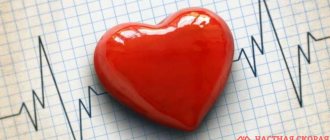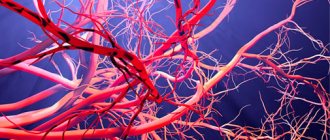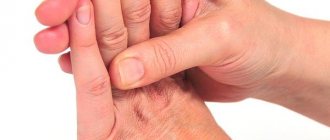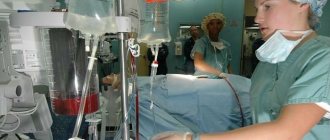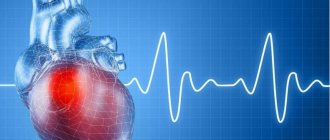Vascular diseases are widespread among middle-aged and elderly people. This is partly facilitated by an inactive lifestyle, monotonous work and poor nutrition, leading to increased cholesterol levels and the formation of plaques with the development of atherosclerosis. The circulatory system supplies blood and nutrients to all organs and tissues. But if there are obstacles in the arterial, venous, or lymphatic vessels, their functionality is impaired, and serious life-threatening complications arise.
Causes of development of vascular diseases
The main vascular disease is atherosclerosis. Against this background, ischemic stroke, ischemic heart disease, obliterating endarteritis and other vascular pathologies often progress. Atherosclerosis is based on arterial damage caused by the accumulation of lipids and the proliferation of endothelial walls. The pathological process involves the arteries of the brain, heart, limbs, and neck. The main causes of vascular damage in the body:
- a high content of animal fats in the diet provokes atherosclerotic changes in blood vessels;
- smoking negatively affects the vascular walls, causes their spasm, and several times increases the risk of developing arterial hypertension and coronary heart disease;
- constant overload of the legs, wearing uncomfortable shoes lead to the development of varicose veins and other vein pathologies;
- frequent infectious diseases are accompanied by intoxication and damage to the vascular walls;
- excess weight is accompanied by impaired fat metabolism and is often a provoking factor in the development of varicose veins, atherosclerosis of the blood vessels of the brain and heart.
The risk of thrombosis and bleeding increases with superficial and internal hemangiomas. These vascular tumors most often undergo reversal, but may begin to actively grow, requiring surgical intervention. Hemangiomas arise mainly due to a failure in the formation of blood vessels at the stage of embryonic development.
Only a qualified specialist can establish the exact causes of vascular pathologies, using extensive diagnostic capabilities. To clarify the diagnosis and assess damage to the vascular system, various studies are prescribed: angiography, MRI, EchoEG, computed tomography, Dopplerography.
Arrhythmia
Treatment for this disease is quite simple if you start this process in a timely manner and do not interrupt it. It is important to undergo examinations on time so that the specialist determines what type of arrhythmias yours belongs to and prescribes the correct complex for eliminating the pathology.
Is arrhythmia treatable?
It is quite possible to eliminate arrhythmia, but it is a pathology that causes side effects if left untreated. Therefore, the earlier the procedures are started, the more effective they will be. Treatment is carried out by cardiologists who prescribe a whole range of actions, including:
- Use of sedative medications. They are usually plant-based. Motherwort, Corvalol, valerian capsules, novopassit help well.
- Medicines that lower blood pressure.
- Beta blockers, membrane stabilizers, potassium channel blockers.
- Useful vitamin complexes (“Riboxin”, “Panangin”, “Magne B6”).
- Physiological procedures are prescribed depending on the patient’s condition. This is a swimming pool, physical therapy, certain training.
- During treatment, a special diet is followed. The doctor describes in detail which foods should be excluded, and, conversely, what to add to the diet. For example, fatty foods, pork, and lard are excluded. You should be careful with tea, coffee, and smoking. Potassium-rich foods are included in the diet. These are dried fruits, honey, banana, black currant. It is also recommended to use parsley, raisins, prunes, and cabbage in your diet. Components rich in calcium and magnesium are also included in the diet.
A set of measures to eliminate the disease includes establishing water balance, giving up alcohol and other bad habits. All this allows us to stabilize the patient’s condition. Of course, in most cases, arrhythmia is eliminated with the help of pharmacological drugs. It is also important to find the root cause of its development.
Cardiac arrhythmia: alternative treatment
Many people are interested in why doctors do not recommend using alternative methods of influencing the body. We are talking about folk recipes. In fact, many experts prescribe such drugs to eliminate pathologies, but not as the main one, but as an additional effect on the body.
Patients, in turn, try to overcome the disease on their own and decide for themselves what they will take. As a rule, this leads to deterioration of health. This is why doctors are skeptical about herbal medicine and traditional healing methods.
Nevertheless, herbal medicine can significantly improve the patient’s condition when used correctly. Some herbs are used to create pharmacological drugs. For example, valerian root, motherwort and the like. They exhibit sedative properties and can relieve stress, nervous tension, and eliminate pain. But the use of herbal medicine is allowed only under the supervision of an experienced specialist. The reason for this is the large number of contraindications for such plants. Valerian root is not always beneficial; it can also cause harm.
We suggest that you familiarize yourself with the list of herbal products that improve the patient’s condition with this disease. But their use is allowed only under the supervision of doctors:
- tinctures of hawthorn, valerian, motherwort;
- tincture of indifference;
- Kirkazon Manchurian;
- evasive peony;
- tincture of calendula;
- Sesame oil;
- infusion of Leuzea safflower;
- chicory.
The list of components that help stop this pathology is very large. But it is worth remembering that only a doctor can help in such a situation. Our clinic helps with arrhythmia, contact us and get rid of the disease. We sincerely wish you good health, but wishes alone are not enough. Take decisive steps towards great health.
How to quickly eliminate pain syndrome
If negative symptoms appear, you should immediately call an ambulance. We recommend calling our center and ordering ambulance services. The car will immediately go to your address, you won’t have to wait long, the team is always ready to instantly respond to a call. But before the arrival of specialists who will provide emergency assistance, you should worry about your health yourself. These actions will help significantly alleviate the condition, and possibly save a life:
- First, medical assistance is called. If you are unable to do this, ask relatives, neighbors, passers-by.
- The heartbeat will return to normal if you gently press your fingers on the eyeballs. This must be done with moderate force, hold for several seconds, and then suddenly release your fingers. Repeat the steps a couple of times.
- Next they induce vomiting. This is done artificially; under no circumstances should you use medications. You should drink a large amount of purified water and induce vomiting by touching the base of your tongue with your fingers. This action often helps save lives.
- The patient should take a deep breath and exhale as much as possible. After this, the nose is pinched, the mouth is closed and the breath is held for several seconds. It is not worth staying in this state for a long time. Sometimes dizziness occurs, so this exercise should be done at the bedside or in a sitting position.
- Ensure air flow, open the window, loosen the collar if the throat is tight with a tie or other clothing.
- Calm down, often unnecessary panic only aggravates the situation. Drink cool water in small sips.
- The use of anti-stress helps very well. This can be any object that is easy to squeeze, bend, but not harm yourself. It distracts from the current situation, removes the feeling of panic and fear.
These techniques are quite simple, everyone can help themselves. As a rule, the condition stabilizes, and many patients refuse hospitalization or specialist help. It is undesirable to make such a decision; it is better to seek help from doctors and find out why this situation arose.
How do vascular diseases manifest themselves?
Clinical manifestations of vascular diseases depend on the location of the pathological area and the degree of its damage. At the initial stage, the disease often occurs without pronounced symptoms, but with regular preventive examinations and laboratory diagnostics, which reveal high cholesterol levels, you can promptly suspect the occurrence of a disorder and seek medical help.
When the blood vessels of the brain are damaged, the following symptoms occur:
- decreased memory and attention;
- dizziness;
- low performance;
- worsening sleep;
- noise in ears.
The development of atherosclerosis of the vessels of the extremities is accompanied by the following changes:
- chilliness of the limbs;
- numbness of the legs;
- pain in the calf muscles, which intensifies while walking;
- pale skin on the legs, tendency to peeling and the formation of trophic ulcers.
Atherosclerosis of the coronary vessels has characteristic manifestations:
- chest pain;
- lack of air;
- fear of death;
- fluctuations in pulse and blood pressure.
Medical intervention if any of the described symptoms appears is mandatory. The doctor prescribes treatment after receiving the results of the examination and examination, assessing the general condition of the patient’s body.
Diagnostics
At the beginning of development, atherosclerosis does not manifest itself in any way. Later, as the disease progresses, several visible manifestations of atherosclerosis appear, which can be identified during a routine examination by a neurologist. This is weight loss, swelling, fatty tissue, and trophic disorders. The doctor will listen to the heart, measure blood pressure, and prescribe clinical tests. The following diagnostic measures are used:
- Ultrasound Dopplerography. Allows you to identify diseases at an early stage, assess the size of plaques and blood flow.
- Coronary angiography is used to assess the condition of the heart vessels.
Which doctor should I contact?
Vascular diseases are the responsibility of an angiologist. This doctor deals directly with pathologies of blood vessels and veins. But the angiologist works closely with other specialists. If necessary, patients can make an appointment with them.
If you have complaints about the condition of the blood vessels, it is recommended that you first visit a therapist or general practitioner. The specialist will conduct an examination, study the symptoms of the disease and medical history, and, if necessary, refer you to a specialist doctor. Diseases of the arteries are treated by a vascular surgeon, diseases of the veins by a phlebologist, diseases of the brain by a neurologist, and diseases of the heart by a cardiologist.
Symptoms of varicose veins
Varicose veins may not cause pain. Signs that indicate varicose veins include:
- Veins are dark purple or blue
- Veins that appear twisted and bulging; they are often like cords on your legs
When painful signs and symptoms occur, they may include:
- Feeling pain or heaviness in the legs
- Burning, throbbing, muscle spasms and swelling in the legs
- Itching around one or more veins
- Change in skin color around varicose veins
Spider veins are similar to varicose veins, but they are smaller. These veins are closer to the surface of the skin and are often red or blue.
Spider veins are found on the legs but can also be found on the face. They vary in size and often look like a spider's web.
Treatment methods
Treatment of blood vessels can be conservative or surgical. Medical tactics depend on the severity of the clinical manifestations of the disease, the patient’s age and general health. When the veins of the extremities are affected, experts prescribe the use of compression hosiery and local agents with a venotonic effect.
It is important to reduce the load on the legs and eliminate the effects of predisposing factors. Shoes should be as loose and comfortable as possible. For varicose veins, the phlebologist must prescribe therapeutic exercises and recommends resting with the leg end elevated at least several times a day to ensure blood flow and normal functioning of the lymphatic system.
For atherosclerosis and high cholesterol, it is recommended to follow a diet limited in fats and simple carbohydrates. Medicines prescribed include nicotinic acid, statins, bile acid sequestrants and other drugs that inhibit the formation of cholesterol plaques and restore fat metabolism.
With the onset of menopause, the risk of developing atherosclerosis in women increases sharply. To prevent vascular damage, hormone replacement therapy is prescribed. The entry into the body of a small amount of estrogens plays a protective role, preventing the occurrence of angina pectoris, coronary heart disease, and atherosclerotic damage to the vascular walls.
If conservative therapy is ineffective and there is a threat to the patient’s life, specialists perform surgical treatment. It involves installing stents at the site of pathological narrowing of the vessel. In case of atherosclerosis of the heart vessels and an increased risk of myocardial infarction, vascular surgeons perform coronary artery bypass grafting.
More possibilities
At the moment when treatment of the initial stages does not make sense, it is necessary to approach treatment issues more responsibly, so you need to look for another specialist whose focus is specifically on blood vessels. Phlebologists are most often involved in the treatment and diagnosis of varicose veins.
Phlebologists are specialists in the field of venous vessels. The algorithm of action of a phlebologist is exactly the same as that of a surgeon, however, treatment and diagnosis will be more constructive.
What a phlebologist can do:
- Inspect;
- Prescribe treatment, both non-operative and surgical;
- If surgery is necessary, send for consultation to a more specialized specialist;
- Prescribe general and local drugs;
- Schedule a consultation with a physical therapy doctor;
- Write out a prescription for compression garments.
If you are firmly confident in your diagnosis, but do not know which doctor to contact for varicose veins, then feel free to choose a phlebologist. Despite the fact that phlebologists are rarely found in the field of free medicine, specialists of this profile are quite often found in large cities, and the cost of an initial appointment is quite affordable.
Prognosis and prevention
With early treatment and prevention of complications, the prognosis is favorable. Vascular pathologies today are successfully treated with conservative and surgical methods, while maintaining the patient’s high quality of life.
Vascular diseases are best prevented by using medications that lower cholesterol levels, as well as products that contain polyunsaturated fatty acids that can prevent the development of atherosclerosis. It is recommended to adhere to the principles of a healthy diet, do not consume fatty and fried foods, and alcohol. It is advisable to quit smoking and start exercising to strengthen the heart muscle and prevent the development of many diseases, including obesity and hypertension. Moderate physical activity has a positive effect on the entire cardiovascular system.
After 30-35 years, check your cholesterol levels and monitor your blood pressure numbers. If symptoms of vascular disorders appear, begin treatment promptly before complete damage to the arteries and veins occurs.
Consultations with a doctor online Taking care of your health is a life priority for everyone.
Communicate with doctors online and receive qualified assistance without leaving your home. Try it Please note! The information on this page is provided for informational purposes only. To prescribe treatment, you must consult a doctor.
Contraindications
Despite the apparent safety and gentleness of the main diagnostic methods, they have a number of absolute and relative contraindications. Doctors use in-depth research techniques with caution when:
- Decompensated heart, liver and kidney failure;
- Allergic reactions to the components of the contrast solution;
- Exacerbation of chronic diseases;
- Infections and inflammations;
- Mental disorders.
Studies are carried out with the utmost caution in pregnant and lactating women, elderly patients and patients with disorders of natural coagulation.
Angiologist: there is such a specialist
Lymphatic and blood vessels are the area of work of an angiologist
If you are offered to visit an angiologist instead of a phlebologist, then feel free to agree, since such a specialist in the field of medicine is practically “relative” to the phlebologist. In a narrower sense, there are individual phlebologists-angiologists.
The doctor's specialization includes direct knowledge of all types of blood vessels. It makes sense to contact an angiologist if differential diagnosis between pathologies of the lymphatic and venous systems is necessary.
Symptoms with which you should contact an angiologist:
- swelling;
- pain and heaviness;
- blood clotting disorder.
In general, angiologists are professionals with a broader profile than phlebologists, so most likely, when clarifying the diagnosis related specifically to the venous vessels, the patient will be redirected to either a phlebologist or a phlebologist-angiologist.
